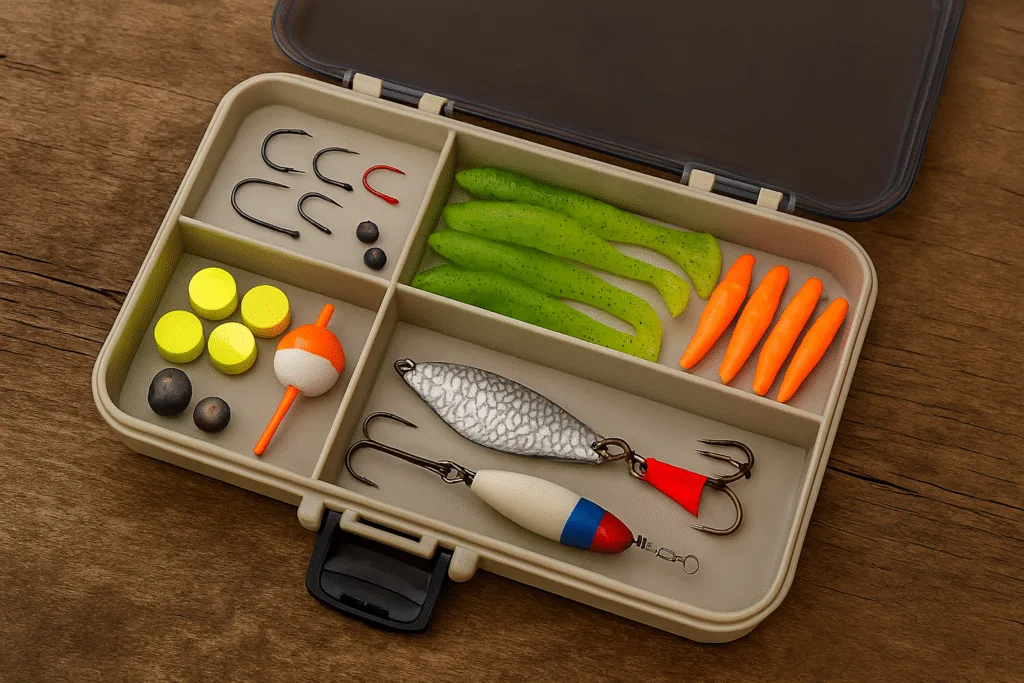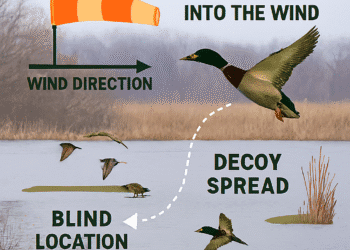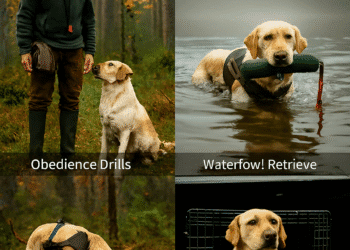Smart, simple fixes from anglers who’ve been there — and don’t want you wasting time untangling hooks when the fish are biting. Tackle box.

Why your tackle box is the unsung hero of every trip
Every angler has been there: you finally reach the water, the hatch is on, or the sonar lights up — and instead of casting, you’re elbow-deep in a mess of tangled lures, rusty hooks, and mystery leaders.
Your tackle box should be your best friend, not your biggest frustration. After years of fishing in Canada’s north — from Yukon rivers to frozen Manitoba lakes — I’ve learned that a few DIY hacks can transform your box into a lean, mean fishing machine.
Here’s how to do it, step by step.
🧰 Hack 1: Build a modular layout – Tackle box
The problem: A cluttered box eats time. The fix: Break it into modules.
How to do it:
- Spread your gear on a table. Group by species (trout, pike, grayling) or technique (fly, jig, troll).
- Cut foam inserts to fit trays and slot lures individually.
- Use pill organizers for tiny items like swivels and split shots.
- Label trays with waterproof tape so you can grab “Grayling Dries” or “Pike Leaders” instantly.
- Test yourself: if you can’t rig in under 30 seconds, reorganize.
👉 For more on species-specific setups, check ADF&G’s sport fishing guides.
🧊 Hack 2: Make it Arctic proof
Fishing in Yukon or Alaska means cold, wet, and icy conditions.
How to do it:
- Add silica gel packs to each tray.
- Store leaders and flies in resealable waterproof bags.
- Seal lids with rubber gaskets or weatherproof tape.
- After every trip, open trays and let them air-dry overnight.
👉 Check Parks Canada’s cold-weather safety tips before heading north.
🧲 Hack 3: Add a magnetic strip
Hooks and weights love to disappear. A magnetic strip keeps them in plain sight.
How to do it:
- Buy adhesive magnetic strips from a hardware store.
- Stick them inside the lid or along a side wall.
- Park treble hooks, swivels, and split shots their mid-rig.
No more digging around while your buddy is already hooked up.
🧒 Hack 4: Make it kid-friendly
Fishing with kids is magical — but only if you keep it safe and simple.
How to do it:
- Dedicate one tray to kid-safe tackle: rubber lures, barbless hooks, floats.
- Color-code compartments so kids know what’s what.
- Add a laminated checklist card with pictures.
- Keep sharp tools in a separate, latched tray.
👉 For regulations on youth fishing, see Fisheries and Oceans Canada.
🧵 Hack 5: Velcro + zip bags
This one’s cheap and brilliant.
How to do it:
- Stick Velcro strips inside your lid.
- Attach heavy-duty zip bags with matching Velcro.
- Label bags by season or species.
- Swap them in and out before each trip.
It’s like having a tackle box that changes with the calendar.
🧼 Hack 6: Rust-proof with household items – Tackle box
Rust is the silent killer of tackle.
How to do it:
- Wipe hooks and tools with a light protectant after trips.
- Drop chalk sticks or silica packs into trays.
- Slide hooks into plastic straws to keep them separated.
- Keep a “rust rehab” bin for gear that needs TLC.
👉 For more gear care, see Trout Unlimited resources.
🧠 Hack 7: Fly fishing layouts – Tackle box
Fly anglers need precision.
How to do it:
- Sort flies by hatch season into clear sleeves.
- Mount a foam strip near the lid for “working flies.”
- Keep leaders, tippet, and flotant in one compact tray.
- Pre-load dries, nymphs, and streamers before grayling trips.
👉 Learn more at the Orvis Fly Fishing Learning Center.
🧊 Hack 8: Ice fishing adaptations – Tackle box
Cold hands + frozen gear = frustration.
How to do it:
- Replace tiny tabs with oversized pulls or paracord loops.
- Line the box with thin insulation.
- Stash hand warmers in side pockets.
- Keep ice jigs in shallow trays with foam slots.
🧠 Hack 9: Rotate seasonally
Why carry everything all year?
How to do it:
- Build four seasonal kits: spring, summer, fall, winter.
- Store them in labeled bins at home.
- Before each trip, load only what you need.
- Audit monthly and purge duplicates.
🧠 Hack 10: Track it digitally – Tackle box
A modern hack for modern anglers.
How to do it:
- Create a Google Sheet or Notion board.
- Track quantity, size, condition, and location.
- Print a QR code linking to your tracker and stick it inside the lid.
- Update after each trip.
No more buying your fifth pack of swivels because you “thought you were out.”
Final Thoughts
A tackle box isn’t just storage — it’s your lifeline on the water. With these hacks, you’ll spend less time fumbling and more time fishing. Whether you’re chasing grayling under Yukon skies, jigging through the ice in Manitoba, or teaching your kids to cast on a summer lake, these small changes make a big difference.
Fishing is supposed to be simple joy. Let your tackle box reflect that.






















